- Bernard Preston homepage
- Breakfast
- Stone Ground Grits
Stone ground grits
Stone ground grits gets bad press for many reasons. It's often not cooked enough; the full-fibre content means it should boil for at least 3/4 of an hour. Better still it should be allowed to retrograde overnight and reheated in the morning.
Then it's difficult to find freshly-milled 100% cornmeal; often some of the bran is removed. You may have to purchase your own grinder.
Food goes through fashion parades, each more horrible than the last. First it was cholesterol that was the whipping boy; then animal protein came into disfavour. Now it is carbs that we are told to eschew if we value our lives. It is all because we are down on what we're not knowledgeable about.
It's refined carbs that are so bad for us, making us obese and setting us firmly on the path to type-2 diabetes; whole grains like grits actually give protection against the disease[1].
Add to that a good dose of laziness and you'll understand why grits is out. Cornflakes are so easy but utterly boring; and a lack of understanding of the science. Have you heard of retrogradation of starches?
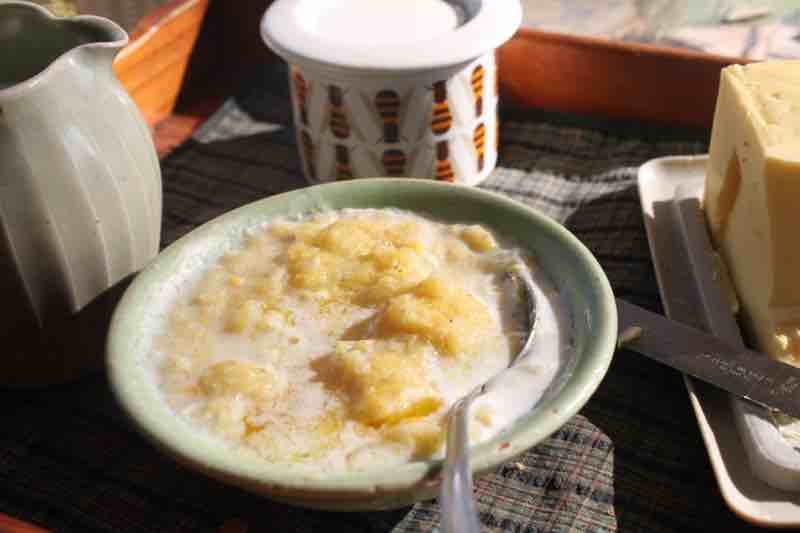
Let's face it, stone ground grits does not have the most amazing flavour; better than cornflakes, mind you. And then in a world where everything must be sickly-sweet folk often ruin their breakfast with copious spoons of sugar.
It takes time for the bran to absorbe all that water so we recommend cooking your grits overnight on low heat; on a woodstove would be perfect but in a wonder-box would be just fine.
Stone ground cheesy grits
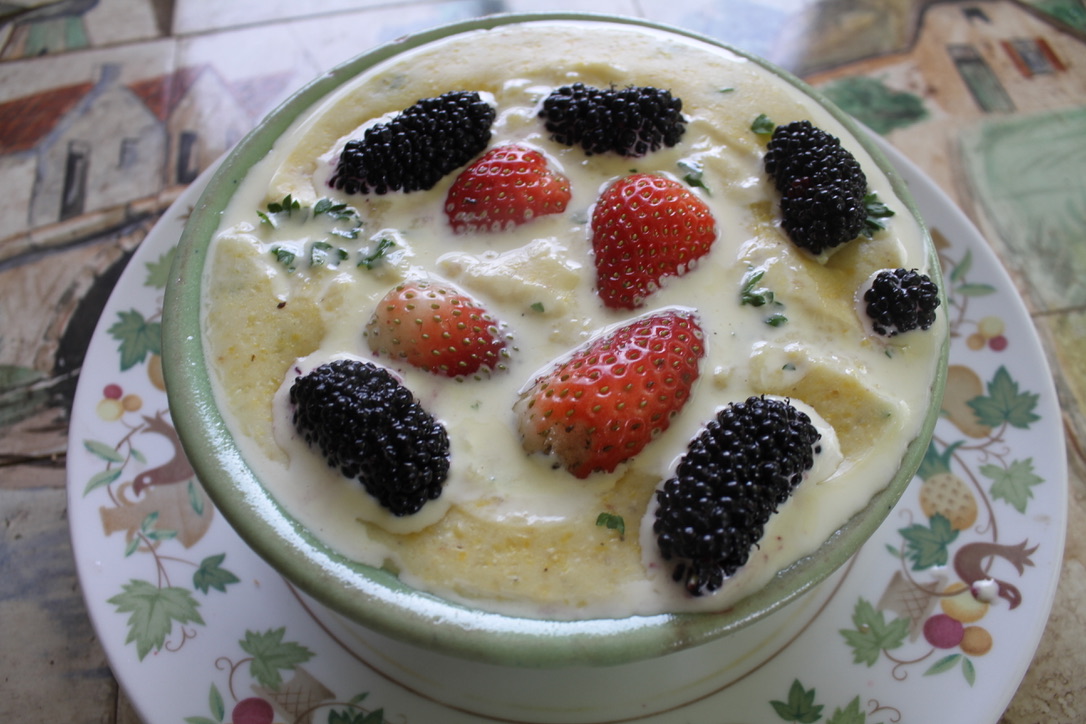
Another reason stone ground grits is held in such poor esteem is that we lack the imagination to cook it in other ways; think about cream and cheese, for example to turn it into a complete meal.
Ingredients
- 1 cup stone-ground cornmeal
- 1 TBSP butter
- 200 ml cream
- 150 g grated cheddar
- 150 g feta cheese
- Handful of fresh or frozen berries
Salt is provided by the feta; add more at the table if so desired.
Cheesy grits is a great favourite.
Go for it
- Add the cornmeal and 1 cup of warm but not hot water to a heavy saucepan. Stir until smooth.
- Add 3 cups of boiling water.
- Use a strainer to skim off the bits of husk that float to the surface; you could just leave them in.
- Turn up the heat, stirring constantly with a wooden spoon until it starts to bubble.
- Cook on low heat for half an hour. Cool and allow your grits to retrograde in the fridge overnight; or leave them on the woodstove.
- Add half a cup of hot water in the morning and bring back to the boil, stirring often on medium heat for 15 minutes.
- Whisk in the butter, cream and some of the cheese; keep stirring.
- Gradually add the rest of the cheese.
- Serve with full-cream milk as desired; add the berries at the table.
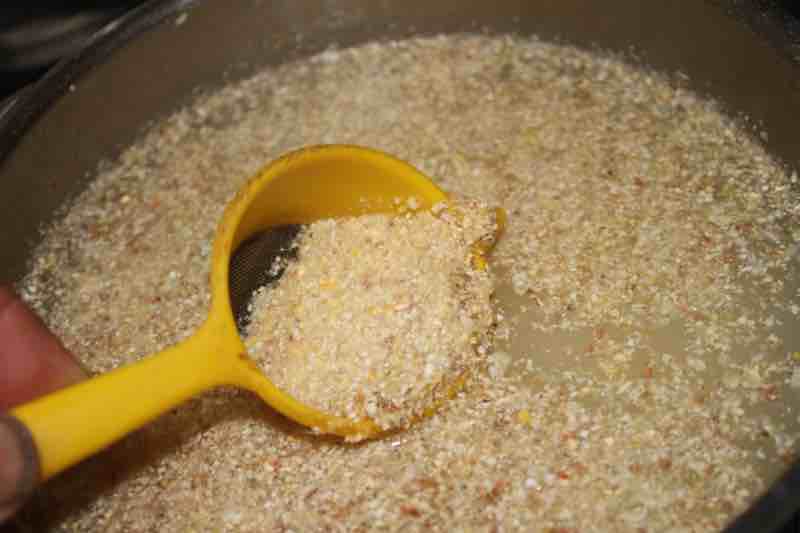 Skim off the chaff.
Skim off the chaff.If you have been eating corn on the cob then save the cooking-water for making your stone ground grits; it adds to the flavour and retains many minerals that would otherwise be lost.
Husk and bran
Husk, hull and shell are the names given to the outer covering of the seed.
When eating corn on the cob you would consume them; they do not contain much nutritional value but they do have some of the lignans, the phytochemical that has a structure very similar to female hormones[4].
Dietary lignans give protection against malignant breast tumours. This is food as medicine in the best sense of the word.
The bran on the other hand is an integral part of the seed. It contains many beneficial vitamins and minerals; and about a third of the protein of the whole grain. It also has the fibre that gives bulk to the stool and nutrients for the friendly flora in the bowel[2].
Millers remove all of the husk and most of the bran and germ, selling them to the pig farmers. We are left with the highly glycemic "polished" grain. It is the chief cause of obesity and stunting of children; much of the protein and other important nutrients have been extracted.
Whole grains are not fattening; refined carbs certainly are. It is they that are the chief cause of obesity.
Hominy grits
Terms like hominy, hull and bran are used very loosely and frankly confusingly on many sites.
Hominy grits is processed with wood ash using an ancient technique called nixtamalisation. Some sites say that only the hull or husk are removed which is fine; but others that the bran and germ are also extracted.
It certainly is a form of processing and just how beneficial or otherwise it is uncertain. Nixtamalisation does increase the availability of niacin; a deficiency causes pellagra. I'm still seeking answers.
The pericarp is the seed coat; it covers the kernel and protects the germ and seed oils from oxidation. Beneath it is the aleurone layer.
Bran makes up the outer layers of the caryopsis consisting of the aleurone and other layers.
Glycemic index
Glycemic index is a measure of how quickly a starch is digested and absorbed into the blood stream.
The common form of quick grits has had the bran and fatty acids removed so it has a high GI of 69; it's fattening and should be avoided by all who value their wellbeing.
However the carbohydrate in unrefined stone ground grits has an extremely low GI of only 5 according to the website Canadian-Insulin; it can be enjoyed by most stable diabetics but it's always wise to keep portion sizes small and take a short walk after all starchy meals.
Add fat and protein to lower the GI still further; cream and cheese.
Shelf life
Once the kernel has been cracked and air gets to the fats they start to go rancid; the oil in stone ground grits has a relatively short shelf-life and the cornmeal may be difficult to find. If you want to eat it regularly then your own mill is the best option; or share one with a group of friends.
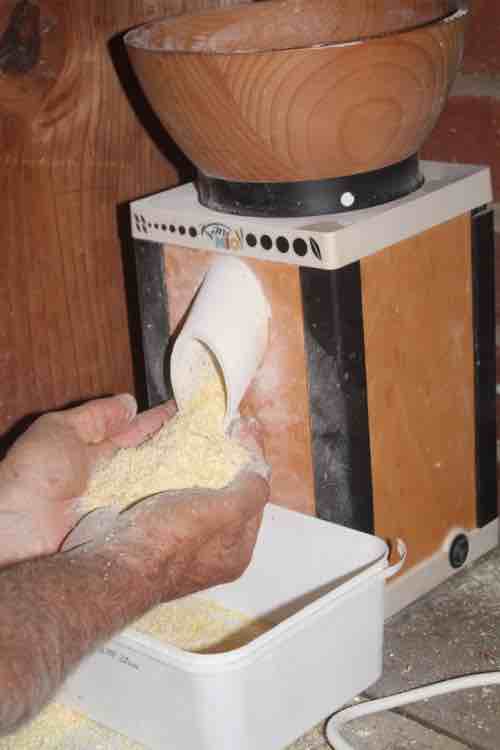
Price
Corn costs around R5 per kilogramme in South Africa; ground into meal using your own mill would provide around ten servings. That's about the cheapest breakfast going. The price would be around 50c per helping; about 3 US cents.
Turn it into cornflakes retailing at over R50/kg and you will have a very expensive breakfast, poor in nutrition.
2 cups of wholemeal corn, weighing 500g makes about five very generous helpings of stone ground grits; about 1 lb of porridge each.
Stone ground grits
Stone ground grits is not only very cheap but it's also a good source of protein; 7 grams in half a cup. There is also plenty of fibre and many of the B vitamins. It also has a lot of minerals particularly iron, magnesium and zinc.
In short the grain in stone ground grits is particularly nutritious and can be enjoyed by all. We have it several times a week throughout the year, alternating with oats and sorghum; except in midsummer when corn on the cob takes the prize.
Purchasing the maize directly from the farmer, freezing it for two weeks and grinding it ourselves makes for very cheap, nutritious food. How to make grits is simple; cook it for half an hour the night before and a few more minutes in the morning.
Retrogradation
If a starch is cooled overnight then the molecules undergo a change of configuration slowing the work of the enzymes in the mouth and small intestine that turn it into glucose. It lowers the GI further still.
So it's always a good practice to cook enough for several days and keep the leftovers in the fridge.
Are grits gluten free?
Grits are indeed gluten-free; wheat, barley and rye are the grains containing this form of protein.
But in fact gluten should not put the fear of the devil into our stomachs; learning about sourdough deals with the problem for the vast majority of folk[3].
Finally are grits healthy? Absolutely provided you don't buy the meal in a box; then it's probably very expensive and fattening.
It's good for your eyes by the way; an excellent source of zeaxanthin and lutein, two carotenoids that help prevent macular degeneration. A large portion is lost if the grits are fried.
The botanical name for corn is zea mays.
Small portions
"Reducing the amount of carbs in the diet has a much better established impact than trying to change the type of starch."
- Prof. F. Sacks, Harvard Medical School
Colorectal malignant tumours
There is a disturbing increase in the number of patients under the age of 50 being diagnosed with malignant colorectal tumours; and in fact many other serious neoplasms of the breast, kidneys and pancreas for example.
The correlation between constipation and colorectal tumours remains controversial. The EPIC study found that doubling the amount of fibre could reduce the risk of these tumours by 40%, but that is now disputed.
In any event stone ground grits is very high in dietary fibre; it will do wonders if you are having difficulties passing a stool. Green leafy vegetables, beetroot and prunes are excellent too.
Breast cancer
Breast cancer is the leading killer of women under the age of 45 in many parts of the world; those enjoying whole grains daily receive almost 50% protection.
"Breast cancer death risk ranks the second in all-age U.S. women and first in those between the ages of 20 and 59[7]."
Facts and figures
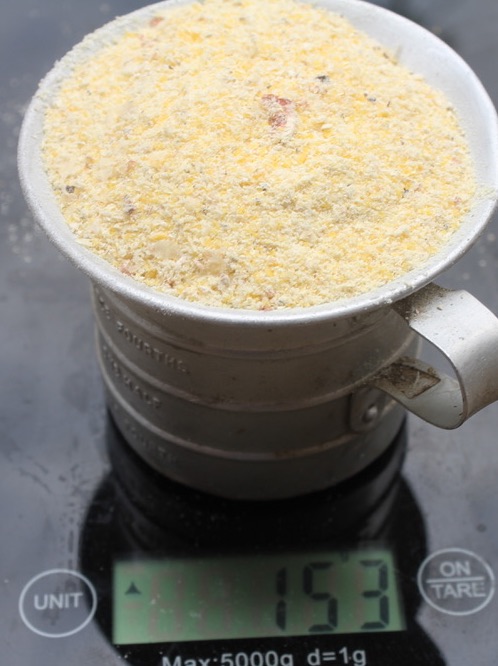 1 Imperial cup weighs 150g approximately. 1 US cup of corn meal weighs 172g.
1 Imperial cup weighs 150g approximately. 1 US cup of corn meal weighs 172g.1 US cup of dry stone-ground grits weighs 172 grams; it will make 4 c of porridge.
One US cup of stone-ground grits porridge, utilising about 43g by dry weight, contains roughly the following according to Web MD.
- 154 calories
- 4g protein
- 1g fat
- 33g carbohydrate.
- According to Canadian Insulin, 1 cup contains 78 grams of carbs, and has a GI of only 5 which is extremely low.
- 1g fibre
- Excellent source of B complex vitamins.
But stone-ground grits contains no B12.
I would not take these figures as gospel; they're the most accurate I can find but there are wildly divergent measures on the web; much refers to partially refined grain.
1kg of wholegrain cornmeal will provide about 27 cups of grits porridge. That would cost about 20 cents per helping in SA currency for those with a mill; and three times that at the commercial price.
- How much is a bowl of wholegrain maize meal? On the farm 16 to 20 South African cents; more realistically commercially including half a cup of milk about one Rand.
Type 2 diabetes
When it comes to food, of one thing we can be sure; there are always caveats and exceptions to the rule. Whilst the research that whole grains like our stone ground grits are extremely nutritious, helping prevent a heap of diseases is unequivocal, there is also disquieting evidence that type-2 diabetics should have a low-carb breakfast[5]. It will help manage "postprandial hyperglycemia;" an excessive rise in blood glucose after the meal, and in fact for the rest of the day.
Diabetics need to test themselves; there's no "one size fits all." The suggestion at least is that just a small helping of stone ground grits for breakfast is advisable; keep the glycemic load down.
They found that an eggs-based breakfast with extra fat, low in carb gave better control of blood glucose. Don't have it on toast if you are diabetic. Have some cream with your grits.
The Xhosa people in South Africa enrich their grits with greens and other vegetables to increase the flavour and supply more nutrients; it's called "umfino."
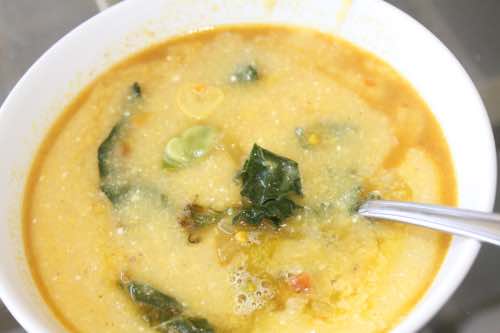
When browsing use right click and "Open Link in New Tab" or you may get a bad gateway signal.
Newsletter
Our newsletter is entitled "create a cyan zone" at your home, preserving both yourself and Mother Earth for future generations; and the family too, of course. We promise not to spam you with daily emails promoting various products. You may get an occasional nudge to buy one of my books.
Here are the back issues.
- Lifestyle and ideal body weight
- What are ultra-processed foods?
- Investing in long-term health
- Diseases from plastic exposure
- Intensive lifestyle management for obesity has limited value
- A world largely devoid of Parkinson's Disease
- The impact of friendly bacteria in the tum on the prevention of cancer
- There's a hole in the bucket
- Everyone is talking about weight loss drugs
- Pull the sweet tooth
- If you suffer from heartburn plant a susu
- Refined maize meal and stunting
- Should agriculture and industry get priority for water and electricity?
- Nature is calling
- Mill your own flour
- Bake your own sourdough bread
- Microplastics from our water
- Alternative types of water storage
- Wear your clothes out
- Comfort foods
- Create a bee-friendly environment
- Go to bed slightly hungry
- Keep bees
- Blue zone folk are religious
- Reduce plastic waste
- Family is important
- What can go in compost?
- Grow broad beans for longevity
- Harvest and store sunshine
- Blue zone exercise
- Harvest and store your rainwater
- Create a cyan zone at your home
Did you find this page interesting? How about forwarding it to a friendly book or food junkie? Better still, a social media tick would help.
- Bernard Preston homepage
- Breakfast
- Stone Ground Grits
Address:
56 Groenekloof Rd,
Hilton, KZN
South Africa
Website:
https://www.bernard-preston.com